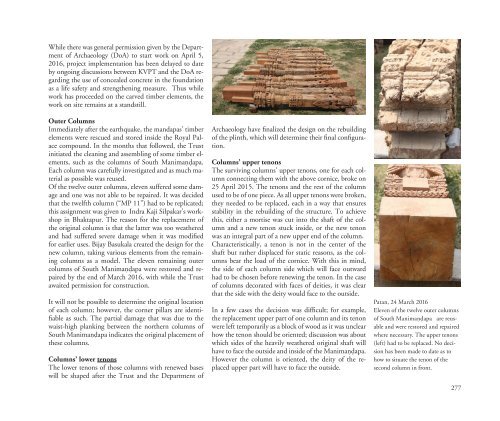KVPT’s Patan Darbar Earthquake Response Campaign - Work to Date - September 2016
Create successful ePaper yourself
Turn your PDF publications into a flip-book with our unique Google optimized e-Paper software.
While there was general permission given by the Department<br />
of Archaeology (DoA) <strong>to</strong> start work on April 5,<br />
<strong>2016</strong>, project implementation has been delayed <strong>to</strong> date<br />
by ongoing discussions between KVPT and the DoA regarding<br />
the use of concealed concrete in the foundation<br />
as a life safety and strengthening measure. Thus while<br />
work has proceeded on the carved timber elements, the<br />
work on site remains at a standstill.<br />
Outer Columns<br />
Immediately after the earthquake, the mandapas’ timber<br />
elements were rescued and s<strong>to</strong>red inside the Royal Palace<br />
compound. In the months that followed, the Trust<br />
initiated the cleaning and assembling of some timber elements,<br />
such as the columns of South Manimaṇḍapa.<br />
Each column was carefully investigated and as much material<br />
as possible was reused.<br />
Of the twelve outer columns, eleven suffered some damage<br />
and one was not able <strong>to</strong> be repaired. It was decided<br />
that the twelfth column (“MP 11”) had <strong>to</strong> be replicated;<br />
this assignment was given <strong>to</strong> Indra Kaji Silpakar’s workshop<br />
in Bhaktapur. The reason for the replacement of<br />
the original column is that the latter was <strong>to</strong>o weathered<br />
and had suffered severe damage when it was modified<br />
for earlier uses. Bijay Basukala created the design for the<br />
new column, taking various elements from the remaining<br />
columns as a model. The eleven remaining outer<br />
columns of South Manimaṇḍapa were res<strong>to</strong>red and repaired<br />
by the end of March <strong>2016</strong>, with while the Trust<br />
awaited permission for construction.<br />
It will not be possible <strong>to</strong> determine the original location<br />
of each column; however, the corner pillars are identifiable<br />
as such. The partial damage that was due <strong>to</strong> the<br />
waist-high planking between the northern columns of<br />
South Manimaṇḍapa indicates the original placement of<br />
these columns.<br />
Columns’ lower tenons<br />
The lower tenons of those columns with renewed bases<br />
will be shaped after the Trust and the Department of<br />
Archaeology have finalized the design on the rebuilding<br />
of the plinth, which will determine their final configuration.<br />
Columns’ upper tenons<br />
The surviving columns’ upper tenons, one for each column<br />
connecting them with the above cornice, broke on<br />
25 April 2015. The tenons and the rest of the column<br />
used <strong>to</strong> be of one piece. As all upper tenons were broken,<br />
they needed <strong>to</strong> be replaced, each in a way that ensures<br />
stability in the rebuilding of the structure. To achieve<br />
this, either a mortise was cut in<strong>to</strong> the shaft of the column<br />
and a new tenon stuck inside, or the new tenon<br />
was an integral part of a new upper end of the column.<br />
Characteristically, a tenon is not in the center of the<br />
shaft but rather displaced for static reasons, as the columns<br />
bear the load of the cornice. With this in mind,<br />
the side of each column side which will face outward<br />
had <strong>to</strong> be chosen before renewing the tenon. In the case<br />
of columns decorated with faces of deities, it was clear<br />
that the side with the deity would face <strong>to</strong> the outside.<br />
In a few cases the decision was difficult; for example,<br />
the replacement upper part of one column and its tenon<br />
were left temporarily as a block of wood as it was unclear<br />
how the tenon should be oriented; discussion was about<br />
which sides of the heavily weathered original shaft will<br />
have <strong>to</strong> face the outside and inside of the Manimaṇḍapa.<br />
However the column is oriented, the deity of the replaced<br />
upper part will have <strong>to</strong> face the outside.<br />
<strong>Patan</strong>, 24 March <strong>2016</strong><br />
Eleven of the twelve outer columns<br />
of South Manimaṇḍapa are reusable<br />
and were res<strong>to</strong>red and repaired<br />
where necessary. The upper tenons<br />
(left) had <strong>to</strong> be replaced. No decision<br />
has been made <strong>to</strong> date as <strong>to</strong><br />
how <strong>to</strong> situate the tenon of the<br />
second column in front.<br />
277




